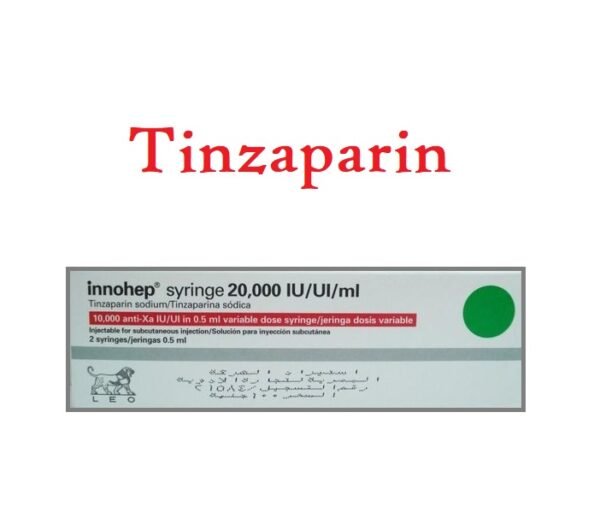Tinzaparin (Innohep) is an LMWH (low molecular weight heparin). It is used in the treatment and prevention of venous thromboembolism (deep vein thrombosis and pulmonary embolism).
Tinzaparin Uses:
Note: Not available in the US
-
Anticoagulation in the extracorporeal circuit during hemodialysis:
-
Used for prevention of clot formation in the extracorporeal system during hemodialysis and hemofiltration in connection with AKI or CKD
-
-
Deep vein thrombosis/pulmonary embolus (treatment):
- Treatment of deep vein thrombosis (DVT) and/or pulmonary embolism (PE).
- Note: In patients with venous thromboembolism (VTE) (ie, DVT or PE) and without malignancy, prefer oral anticoagulants over LMWH (unless LMWH is used as initial parenteral anticoagulation before dabigatran, edoxaban, or while initiating warfarin). In patients with malignancy suffering from venous thromboembolism (VTE) (ie, DVT or PE), LMWH should be preferred over oral anticoagulants for initial and long-term treatment as per ACCP recommendations.
-
Postoperative thromboprophylaxis:
- Venous thromboembolism (VTE) prophylaxis in high-risk patients following orthopedic surgery general surgery.
-
Off Label Use of Tinzaparin in Adults:
- For bridging anticoagulation therapy with mechanical prosthetic heart valve (aortic or mitral position); prophylaxis for VTE in patients undergoing bariatric surgery at moderate to high risk for VTE
Tinzaparin (Innohep) dose in Adults
For bridging anticoagulation therapy with mechanical prosthetic heart valve (aortic or mitral position): Subcutaneous: 175 anti-Xa units/kg per 24 hours
Tinzaparin (Innohep) dose in the prophylaxis of venous thromboembolism:
-
Patients undergoing bariatric surgery who are at a moderate to high VTE risk (off-label use):
- Based on limited evidence: Subcutaneous Initial: 75 anti-Xa units/kg per 24 hours starting on 1st postoperative day (minimum dose: 4,500 anti-Xa units per 24 hours and maximum dose: 14,000 anti-Xa units per 24 hours);
- The dose should be rounded off to the closest possible syringe size; therapy is given for 10 days postoperatively.
- Note: Optimal duration of prophylaxis is not known, but depending on the risk of VTE it is usually continued during the hospital stay and depending upon the risk of VTE, may be extended for up to one and a half month postoperatively.
-
Hip replacement surgery:
Note: It is recommended to start LMWH ≥12 hours preoperatively or ≥12 hours postoperatively; treatment extension up to 35 days is suggested.
-
- Preoperative regimen: Subcutaneous: 50 anti-Xa units/kg given 2 hours preoperatively followed by 50 anti-Xa units/kg per 24 hours for 7 to 10 days
- Postoperative regimen: SubQ: 75 anti-Xa units/kg per 24 hours, with initial dose given postoperatively and continued for 7 to 10 days
-
Knee replacement surgery:
- SubQ: 75 anti-Xa units/kg per 24 hours, given initial dose postoperatively and continue for 7 to 10 days. Note: It is recommended to start LMWH ≥12 hours preoperatively or ≥12 hours postoperatively; it is suggested to extend the duration to up to 35 days. May also consider bodyweight dosing using prefilled syringes.
-
General surgery:
- Subcutaneous: 3,500 anti-Xa units per 24 hours, give initial dose 2 hours before surgery and then continue after surgery for 7 to 10 days
Anticoagulant in the extracorporeal circuit during hemodialysis (recommendations apply to stable patients with chronic renal failure): IV:
- Dialysis session ≤4 hours (no hemorrhage risk):
- Initial bolus (via the arterial side of circuit or IV): 4,500 anti-Xa units should be administered at the start of dialysis; typically achieves plasma concentrations of 0.5 to 1 anti-Xa unit/mL is typically achieved; larger bolus may be given for dialysis sessions of more than 4 hours. For subsequent dialysis sessions, the dose may be adjusted as necessary in increments of 500 anti-Xa units based on the previous outcome.
- Dialysis session >4 hours (hemorrhage risk):
- Initial bolus (IV only): 2,250 anti-Xa units should be administered at the start of dialysis (do not add to dialysis circuit). May give a smaller 2nd IV dose during dialysis sessions of more than 4 hours. For subsequent dialysis sessions, the dose should be adjusted as necessary to achieve plasma concentrations of 0.2 to 0.4 anti-Xa units/mL.
Tinzaparin (Innohep) Dose in the treatment of venous thromboembolism:
Note: For timing of initiating oral anticoagulants, see Transitioning between anticoagulants. For patients with active cancer, see VTE treatment in patients with active cancer.
-
DVT and/or PE treatment:
- Inpatient treatment: SubQ: 175 anti-Xa units/kg per 24 hours;
- The maximum dose: 18,000 anti-Xa units/ per 24 hours. Note: Outpatient treatment may be considered in a selective group of patients for the remainder of the course after giving the first dose in a hospital or urgent care center.
- Duration of therapeutic anticoagulation (first episode, general recommendations): Optimal duration of therapy is not known and is determined by the factors like presence of or absence of provoking events, patient risk factors for recurrence and bleeding, and the preference of an individual.
-
Provoked VTE:
- Three months provided that the provoking risk factor has been corrected
-
Unprovoked PE or DVT (proximal or isolated distal):
- ≥3 months depending on the risk recurrence of VTE recurrence and bleeding
Note: Periodically assess all patients receiving indefinite therapeutic anticoagulation.
Tinzaparin (Innohep) dose in the treatment of VTE in patients with active cancer:
-
Months 1 to 6:
- Subcutaneous :Initial: 175 anti-Xa units/kg per 24 hours for 5 to 10 days followed by long-term anticoagulation for a total duration of 3 to 6 months.
-
Maintenance beyond 6 months:
- ACCP and ASCO guidelines for prophylaxis/treatment of VTE have recommended considering continuing anticoagulation beyond 6 months in selective patients as there is a persistently high risk of recurrence in those with active malignancy; risk vs benefit of bleeding and recurrence should be considered.
-
Transitioning between anticoagulants:
-
-
Transitioning from another anticoagulant to tinzaparin:
- Transitioning from therapeutic IV UFH infusion to therapeutic-dose tinzaparin: UFH should be stopped and tinzaparin should be started within 1 hour. Note: Local protocols should be consulted if aPTT is not in the therapeutic range at the time UFH is discontinued.
-
Transitioning from tinzaparin to another anticoagulant:
- Transitioning from therapeutic-dose tinzaparin to therapeutic IV UFH infusion: IV UFH should be started (rate based on indication) 1 to 2 hours before the next dose of tinzaparin would have been due. Note: Omit IV UFH loading dose should be omitted.
- Transitioning from prophylactic tinzaparin to therapeutic IV UFH: Start UFH without delay. Use a UFH bolus/loading if indicated.
- Transitioning from therapeutic-dose tinzaparin to warfarin for VTE treatment: Warfarin should be started on the 1st or 2nd day of treatment and overlapped with tinzaparin until INR is ≥2 for at least 2 measurements ~24 hours apart (duration of overlap is usually 4 to 5 days).
- Transitioning from therapeutic-dose tinzaparin to warfarin for nonvalvular atrial fibrillation: Warfarin is usually started without bridging therapy in patients, not at high risk of immediate thromboembolism. May consider overlapping with tinzaparin until INR is within the therapeutic range (bridging) in patients at high risk of immediate thromboembolism.
- Transitioning from therapeutic-dose tinzaparin to a direct oral anticoagulant (DOAC): Note: Some DOACs (dabigatran, edoxaban) require 5 days of parenteral anticoagulation prior to transitioning may be required in the treatment of VTE
- General transition recommendation: DOAC should be started within 2 hours prior to the next scheduled dose of tinzaparin.
-
VTE initial treatment transition (alternative recommendation):
For acute VTE, some experts consider starting DOAC within 12 to 24 hours after a LMWH regimen of once a day.
Tinzaparin (Innohep) dose in Childrens
Note: 1 mg of tinzaparin equals 70 to 120 units of anti-Xa activity
Tinzaparin (Innohep) for the treatment of DVT and/or PE treatment: SubQ:
-
Infants, Children, and Adolescents:
Note: A vitamin K antagonist may be started on day 1 of tinzaparin therapy; if INR is not >2, discontinue tinzaparin on day 6 or later.
-
- Birth to 2 months: 275 anti-Xa units/kg per 24 hours
- 2 to 12 months: 250 anti-Xa units/kg per 24 hours
- 1 to 5 years: 240 anti-Xa units/kg per 24 hours
- 5 to 10 years: 200 anti-Xa units/kg per 24 hours
- 10 to 16 years: 175 anti-Xa units/kg per 24 hours
Pregnancy Risk Category: B
- Women who are pregnant or planning to have children should not use this product.
- Tinzaparin is not known to cross the placenta and there have been no reports of increased risk of fetal bleeding.
- LMWH in pregnancy treatment of acute VTE is preferable to UFH
- Stop using LMWH before labor or a planned ssection.
- Women who are having a cesarean section or have other risk factors for developing VTE may consider using LMWH prophylactically.
- Take into consideration the following: Fetal outcomes (ie. Malformations, pregnancy loss, and maternal outcomes (ie. VTE, hemorhage, the burden of treatment and maternal preference.
- Multiple-dose vials may contain benzyl alcohol. They can cause gasping syndrome in infants and pregnant women should not use them. Preservative-free formulas are best.
Use during breastfeeding:
- Breast milk is very low in LMWH and therefore it is unlikely to cause adverse reactions in a nursing baby.
- May continue LMWH while breastfeeding.
Dose in Kidney Disease:
- CrCl ≥30 mL/minute:
- No dosage adjustments provided in the manufacturer's labeling; however, drug clearance is decreased in renal impairment as it primarily has renal elimination. Use cautiously
- CrCl <30 mL/minute:
- According to the evidence, no accumulation occurs in patients with CrCl down to 20 mL/minute, but limited data is available in patients with a CrCl <20 mL/minute. According to the manufacturer recommends that a dose reduction be considered in patients with CrCl <30 mL/minute, but no specific dosage adjustments provided in the manufacturer's labeling; Use cautiously.
- Hemodialysis:
- Not dialyzable
Dose in Liver disease:
- No dosage adjustments provided in the manufacturer’s labeling.
- Does not undergo hepatic metabolism does not occur; however, it may cause a transient increase in transaminase levels; use cautiously.
As with all anticoagulants, the major adverse effect of tinzaparin is bleeding. May cause hemorrhage at virtually any site. Multiple variables may contribute to the risk.
Common Side Effects of Tinzaparin (Innohep):
-
Hepatic:
- Increased serum ALT
-
Local:
- Hematoma at the injection site
Less Common Side Effects of Tinzaparin (Innohep):
-
Cardiovascular:
- Chest Pain
- Angina Pectoris
- Cardiac Arrhythmia
- Coronary Thrombosis
- Myocardial Infarction
- Thromboembolism
-
Central Nervous System:
- Headache
- Pain
-
Dermatologic:
- Bullous Rash
- Erythematous Rash
- Maculopapular Rash
- Skin Necrosis
-
Endocrine & Metabolic:
- Dependent Edema
-
Gastrointestinal:
- Nausea
- Abdominal Pain
- Constipation
- Diarrhea
- Vomiting
-
Genitourinary:
- Urinary Tract Infection
-
Hematologic & Oncologic:
- Granulocytopenia
- Hemorrhage
- Neoplasm
- Thrombocytopenia
-
Hepatic:
- Increased Serum AST
-
Hypersensitivity:
- Hypersensitivity Reaction
-
Local:
- Cellulitis At Injection Site
-
Neuromuscular & Skeletal:
- Back Pain
-
Respiratory:
- Epistaxis
- Dyspnea
Contraindications to Tinzaparin (Innohep):
- Hypersensitivity to heparin, tinzaparin or other low molecularweight heparins (LMWH), and any component of the formulation
- Active bleeding due to a local lesion, such as a gastric, duodenal, or ulcerating carcinoma
- History of immunologically mediated, heparin-induced hemoglobinuria (confirmed/susspected) or positive in vitro platelet aggregation tests in the presence tinzaparin
- Septic endocarditis, acute or subacute
- Hemorrhage in active major or other conditions/diseases that increase the risk of hemorhage (eg: imminent abortion, severe hepatic impairment, imminent pregnancy); hemophilia, major blood clotting disorder
- Acute cerebral injury or hemorhagic cerebrovascular accident without systemic emboli
- Hypertension(uncontrolled severe)
- Hemorrhagic or diabetic retinopathy
- Surgery or injury to the brain, spine, eyes, ears, or brain
- Patients who require treatment dosages for tinzaparin may need spinal/epidural anesthesia
- Multi-dose vials containing benzoyl alcohol for children under 3 years of age, neonates, and premature infants
Notice:
- Tinzaparin should be avoided when used in conjunction with HIT.
- Tinzaparin with thrombosis or HIT with current HIT is not recommended.
- Tinzaparin is also contraindicated because of its high cross-reactivity with the heparin-platelet-factor-4 antibody.
Warnings and precautions
-
Bleeding
- Any site may cause bleeding.
- Closely monitor for bleeding.
- Patients at higher risk of bleeding should exercise extreme caution.
- There are several risk factors for bleeding: bacterial endocarditis, congenital and acquired bleeding disorders, active ulcerative or angiodysplastic GI disease; severe uncontrolled hypertension; hemorhagic stroke; use soon after brain, spine, or ophthalmology surgeries; patients who have been treated with platelet inhibitors, SSRIs; recent GI bleeding, ulceration; qualitative, quantitative platelet defects; diabetic retinopathy or hypertensive; or patients undergoing invasive surgery
- If a patient has bleeding, the medication should be stopped
- Contraindication: Active major bleeding. Protamine may be considered as partial reversal in cases of overdose (consult the Protamine monograph to learn more about dosing recommendations).
-
Hyperkalemia:
- Monitor potassium levels
- Hyperkalemia could be caused by a reduction in aldosterone levels.
- Patients with hyperkalemia are more likely to experience it.
-
Thrombocytopenia:
- This may cause thrombocytopenia, including thrombocytopenia and thrombosis. Pay attention to your platelet count.
- Contraindication: HIT and HIT with thrombosis are not recommended.
- Patients with platelet counts below 100,000/mm or patients who have developed thrombosis due to the induction of dalteparin should be stopped immediately.
- Avoid contact with platelet defect or congenital thrombocytopenia.
-
Thrombocytosis
- Asymptomatic thrombocytosis may occur in patients who have undergone orthopedic surgery, or are subject to concurrent inflammation.
- If platelet counts rise, discontinue use and seek further treatment.
-
GI ulceration
- Be careful.
-
Hepatic impairment
- Take care as it may lead to dose-dependent increases of AST/ALT/GGT
-
Prosthetic heart valves:
- Patients receiving thromboprophylaxis treatment with LMWHs have reported protruding valve thrombosis.
- Women who are pregnant may be at greater risk
-
Renal impairment
- Be cautious; decreased clearance has been observed with CrCl =50mL/minute. Patients with CrCl30mL/minute should consider dosage reduction.
Tinzaparin (United States: Not available): Drug Interaction
|
5-Aminosalicylic Acid Derivatives |
May enhance the adverse/toxic effect of Heparins (Low Molecular Weight). Specifically, the risk for bleeding/bruising may be increased. |
|
Agents with Antiplatelet Properties (e.g., P2Y12 inhibitors, NSAIDs, SSRIs, etc.) |
May enhance the anticoagulant effect of Anticoagulants. |
|
Aliskiren |
Heparins (Low Molecular Weight) may enhance the hyperkalemic effect of Aliskiren. |
|
Angiotensin II Receptor Blockers |
Heparins (Low Molecular Weight) may enhance the hyperkalemic effect of Angiotensin II Receptor Blockers. |
|
Angiotensin-Converting Enzyme Inhibitors |
Heparins (Low Molecular Weight) may enhance the hyperkalemic effect of Angiotensin-Converting Enzyme Inhibitors. |
|
Antithrombin |
May enhance the anticoagulant effect of Heparins (Low Molecular Weight). |
|
Bromperidol |
May enhance the adverse/toxic effect of Anticoagulants. |
|
Caplacizumab |
May enhance the anticoagulant effect of Anticoagulants. |
|
Collagenase (Systemic) |
Anticoagulants may enhance the adverse/toxic effect of Collagenase (Systemic). Specifically, the risk of injection site bruising and/or bleeding may be increased. |
|
Dasatinib |
May enhance the anticoagulant effect of Anticoagulants. |
|
Deferasirox |
Anticoagulants may enhance the adverse/toxic effect of Deferasirox. Specifically, the risk for GI ulceration/irritation or GI bleeding may be increased. |
|
Deoxycholic Acid |
Anticoagulants may enhance the adverse/toxic effect of Deoxycholic Acid. Specifically, the risk for bleeding or bruising in the treatment area may be increased. |
|
Eplerenone |
Heparins (Low Molecular Weight) may enhance the hyperkalemic effect of Eplerenone. |
|
Factor X (Human) |
Anticoagulants (Inhibitors of Factor Xa) may diminish the therapeutic effect of Factor X (Human). |
|
Fat Emulsion (Fish Oil Based) |
May enhance the anticoagulant effect of Anticoagulants. |
|
Ibritumomab Tiuxetan |
Anticoagulants may enhance the adverse/toxic effect of Ibritumomab Tiuxetan. Both agents may contribute to an increased risk of bleeding. |
|
Ibrutinib |
May enhance the adverse/toxic effect of Anticoagulants. |
|
Inotersen |
May enhance the anticoagulant effect of Anticoagulants. |
|
Limaprost |
May enhance the adverse/toxic effect of Anticoagulants. The risk for bleeding may be increased. |
|
Nintedanib |
Anticoagulants may enhance the adverse/toxic effect of Nintedanib. Specifically, the risk for bleeding may be increased. |
|
Nonsteroidal Anti-Inflammatory Agents |
May enhance the anticoagulant effect of Anticoagulants. |
|
Obinutuzuma |
Anticoagulants may enhance the adverse/toxic effect of Obinutuzumab. Specifically, the risk of serious bleeding-related events may be increased. |
|
Omega-3 Fatty Acids |
May enhance the anticoagulant effect of Anticoagulants. |
|
Palifermin |
Heparins (Low Molecular Weight) may increase the serum concentration of Palifermin. |
|
Pentosan Polysulfate Sodium |
May enhance the anticoagulant effect of Anticoagulants. |
|
Pentoxifylline |
May enhance the anticoagulant effect of Heparins (Low Molecular Weight). |
|
Potassium Salts |
Heparins (Low Molecular Weight) may enhance the hyperkalemic effect of Potassium Salts. |
|
Potassium-Sparing Diuretics |
Heparins (Low Molecular Weight) may enhance the hyperkalemic effect of Potassium-Sparing Diuretics. Management: Monitor serum potassium concentrations closely. The spironolactone Canadian product monograph lists its combination with heparin or low molecular weight heparins as contraindicated. |
|
Prostacyclin Analogues |
May enhance the adverse/toxic effect of Anticoagulants. Specifically, the antiplatelet effects of these agents may lead to an increased risk of bleeding with the combination. |
|
Salicylates |
May enhance the anticoagulant effect of Anticoagulants. |
|
Sugammadex |
May enhance the anticoagulant effect of Anticoagulants. |
|
Sulodexide |
May enhance the anticoagulant effect of Anticoagulants. |
|
Thrombolytic Agents |
May enhance the anticoagulant effect of Anticoagulants. Management: See full drug monograph for guidelines for the use of alteplase for acute ischemic stroke during treatment with oral anticoagulants. |
|
Tibolone |
May enhance the anticoagulant effect of Anticoagulants. |
|
Tipranavir |
May enhance the anticoagulant effect of Anticoagulants. |
|
Vitamin E (Systemic) |
May enhance the anticoagulant effect of Anticoagulants. |
|
Vitamin K Antagonists (eg, warfarin) |
Anticoagulants may enhance the anticoagulant effect of Vitamin K Antagonists. |
|
Desirudin |
Anticoagulants may enhance the anticoagulant effect of Desirudin. |
|
Estrogen Derivatives |
|
|
Herbs (Anticoagulant/Antiplatelet Properties) (eg, Alfalfa, Anise, Bilberry) |
May enhance the adverse/toxic effect of Anticoagulants. Bleeding may occur. Management: Avoid such combinations when possible. If used concomitantly, increase diligence in monitoring for adverse effects (eg, bleeding, bruising, altered mental status due to CNS bleeds). |
|
Progestins |
May diminish the therapeutic effect of Anticoagulants. More specifically, the potential prothrombotic effects of some progestins and progestin-estrogen combinations may counteract anticoagulant effects. Management: Carefully weigh the prospective benefits of progestins against the potential increased risk of procoagulant effects and thromboembolism. Use is considered contraindicated under some circumstances. Refer to related guidelines for specific recommendations. |
|
Risk Factor X (Avoid combination) |
|
|
Apixaban |
May enhance the anticoagulant effect of Anticoagulants. Refer to separate drug interaction content and to full drug monograph content regarding use of apixaban with vitamin K antagonists (eg, warfarin, acenocoumarol) during anticoagulant transition and bridging periods. |
|
Dabigatran Etexilate |
May enhance the anticoagulant effect of Anticoagulants. Refer to separate drug interaction content and to full drug monograph content regarding use of dabigatran etexilate with vitamin K antagonists (eg, warfarin, acenocoumarol) during anticoagulant transition and bridging periods. |
|
Edoxaban |
May enhance the anticoagulant effect of Anticoagulants. Refer to separate drug interaction content and to full drug monograph content regarding use of edoxaban with vitamin K antagonists (eg, warfarin, acenocoumarol) during anticoagulant transition and bridging periods. Management: Some limited combined use may be indicated during periods of transition from one anticoagulant to another. See the full edoxaban drug monograph for specific recommendations on switching anticoagulant treatment. |
|
Hemin |
May enhance the anticoagulant effect of Anticoagulants. |
|
MiFEPRIStone |
May enhance the adverse/toxic effect of Anticoagulants. Specifically, the risk of bleeding may be increased. |
|
Omacetaxine |
Anticoagulants may enhance the adverse/toxic effect of Omacetaxine. Specifically, the risk for bleeding-related events may be increased. Management: Avoid concurrent use of anticoagulants with omacetaxine in patients with a platelet count of less than 50,000/uL. |
|
Rivaroxaban |
Anticoagulants may enhance the anticoagulant effect of Rivaroxaban. Refer to separate drug interaction content and to full drug monograph content regarding use of rivaroxaban with vitamin K antagonists (eg, warfarin, acenocoumarol) during anticoagulant transition and bridging periods. |
|
Urokinase |
May enhance the anticoagulant effect of Anticoagulants. |
|
Vorapaxar |
May enhance the adverse/toxic effect of Anticoagulants. More specifically, this combination is expected to increase the risk of bleeding. |
Monitoring parameters:
- Periodic monitoring of CBC with platelet count (at baseline then periodically throughout therapy)
- Kidney function (use Cockcroft-Gault formula)
- Liver function
- Serum potassium (baseline and regularly thereafter in patients at risk for hyperkalemia)
- Stool for occult blood.
- Routine monitoring is not required for anti-Xa activity but has been utilized in patients with obesity and/or renal insufficiency. Anti-Xa activity can appropriately measure the therapeutic effect but poorly predicts hemorrhagic risk.
- Measure peak anti-Xa levels 4 to 6 hours after administration.
- Monitoring of PT and/or aPTT is required
How to administer Tinzaparin (Innohep)?
Subcutaneous:
- The patient should be sitting or in a lying down position.
- Should be administered by deep subcutaneous injection into the lower abdomen (avoiding umbilical area), outer thigh, lower back, or upper arm.
IM injection should not be given. Daily rotate injection site. The injection site should not be rubbed to minimize bruising. May be administered into the arterial side of the dialyzer circuit or IV in patients with no hemorrhage risk, during hemodialysis. Given only via IV route in patients at risk of hemorrhage.
Mechanism of action of Tinzaparin (Innohep):
It's an LMWH with an average weight of 5,500 to 7,500 daltons [10%], 2,000 to 8,000 daltons[60%-722%], >8,000 daltons[22%–36 that causes binding to antithrombin 1 and inhibits many clotting factors, particularly factor Xa. Tinzaparin's antiXa activity ranges from 70 to 120 units/mg. It also has a higher ratio of anti-factor Xa to anti-factor Ia activity than UFH.
Note: Values reflective of anti-Xa activity. Duration: Detectable anti-Xa activity persists for 1 day Absorption: The absorption is slow and half-life after subcutaneous administration is almost 180 mins. Distribution: 4 L Metabolism: No hepatic metabolism Bioavailability: ~90% with subcutaneous administration Half-life elimination: 82 minutes increases with renal impairment Time to peak: 4 to 6 hours Excretion: Excreted via urine
International Brand Names of Tinzaparin:
- Innohep
- Innohep-PFS
- Logiparin
Tinzaparin Brand Names in Pakistan:
Tinzaparin Sodium Injection 10000 IU/ml |
|
| Innohep | Zam Zam Corporation |




 Injection.webp)